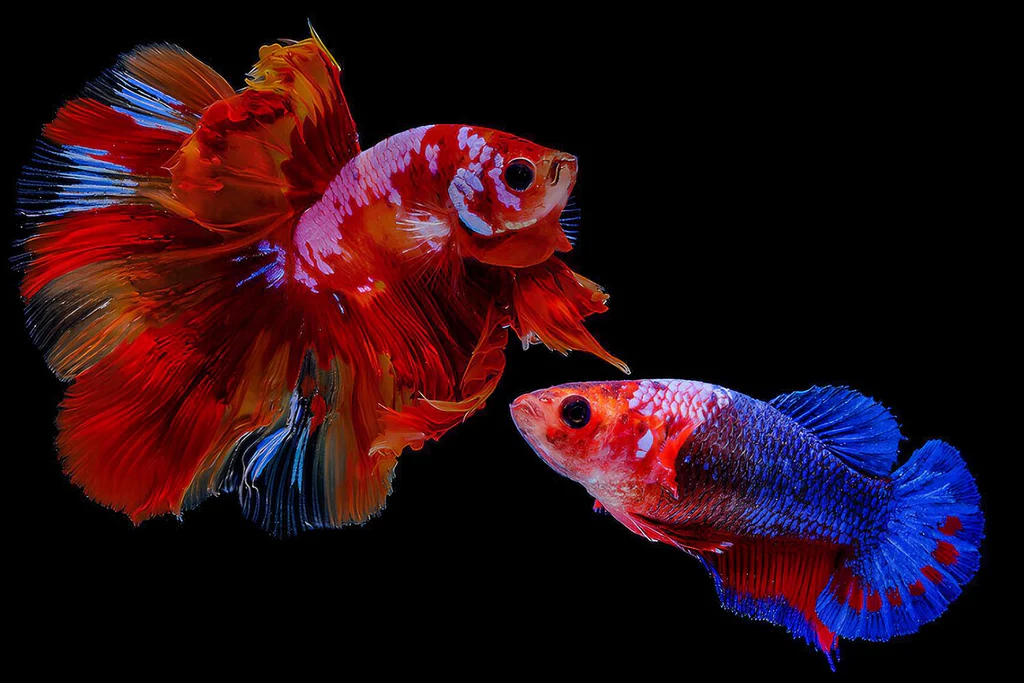Female bettas, also known as Siamese fighting fish, are beautiful and vibrant creatures that can make wonderful pets. While they are often overshadowed by their male counterparts, female bettas have their unique charm and personality. Proper care is essential to ensure they thrive in captivity. In this guide, we will cover everything you need to know about female betta care, including tank setup, diet, health, and more.
Tank Setup

1. Tank Size
- Minimum Size: A minimum tank size of 5 gallons is recommended for a single female betta. Larger tanks provide more stable water conditions and allow for better swimming space.
- Group Housing: If you plan to keep multiple female bettas together (a sorority), a tank of at least 10 gallons is ideal to prevent territorial disputes.
2. Water Conditions
- Temperature: Female bettas thrive in water temperatures between 76°F to 82°F (24°C to 28°C). A heater is often necessary to maintain a consistent temperature.
- pH Level: The ideal pH range for female bettas is between 6.5 to 7.5. Regular testing of water parameters is essential.
- Filtration: A gentle filter is recommended to keep the water clean without creating strong currents, which can stress the fish.
3. Tank Decor
- Hiding Places: Provide plenty of hiding spots using plants, caves, and decorations. This helps reduce stress and allows female bettas to establish territories.
- Live or Silk Plants: Live plants not only enhance the aesthetics of the tank but also provide hiding spots. If using artificial plants, ensure they are silk or smooth to prevent fin damage.
Diet
1. Types of Food
- High-Quality Betta Pellets: Choose pellets specifically formulated for bettas, as they provide the necessary nutrients.
- Frozen or Live Foods: Supplement their diet with frozen or live foods like bloodworms, brine shrimp, and daphnia to enhance their health and color.
- Vegetables: Occasionally, you can offer blanched peas or spinach to provide fiber.
2. Feeding Schedule
- Frequency: Feed your female betta 1-2 times a day, offering only what she can consume in 2-3 minutes to prevent overfeeding and water pollution.
- Variety: Rotate between different types of food to ensure a balanced diet.
Health and Maintenance
1. Regular Water Changes
- Frequency: Perform partial water changes of 25-50% weekly to maintain water quality. In a heavily stocked tank, more frequent changes may be necessary.
- Conditioning: Always use a water conditioner to remove chlorine and chloramines from tap water.
2. Signs of Illness
- Behavior Changes: Monitor for signs of stress or illness, such as lethargy, loss of appetite, or unusual swimming patterns.
- Physical Symptoms: Look for signs like discoloration, frayed fins, or white spots (ich) that may indicate health issues.
3. Quarantine New Fish
- Isolation: When introducing new fish, quarantine them for at least two weeks to prevent the spread of disease to your established betta.
Social Behavior
1. Sorority Setup
- Choosing Tankmates: If you want to keep multiple female bettas, introduce them to a larger tank with plenty of hiding spots. Monitor their behavior closely to prevent aggression.
- Compatibility: Female bettas can coexist with other peaceful species, such as tetras, rasboras, and snails, but avoid keeping them with aggressive fish.
2. Individual Personalities
- Unique Traits: Each female betta has its own personality. Some may be more territorial or aggressive than others, so it’s essential to observe their interactions.
Conclusion
Caring for female bettas can be a rewarding experience, as they are beautiful and interactive pets. By providing a suitable tank environment, a balanced diet, and regular health checks, you can ensure your female betta thrives and brings joy to your home. Remember to observe their behavior and make adjustments as needed to create a harmonious living space. With proper care, your female betta will flourish and become a beloved companion for years to come!

Related Posts
Understanding Betta Fish Water
What Are Clamped Fins On Betta?
How Many Betta Fish Diseases?